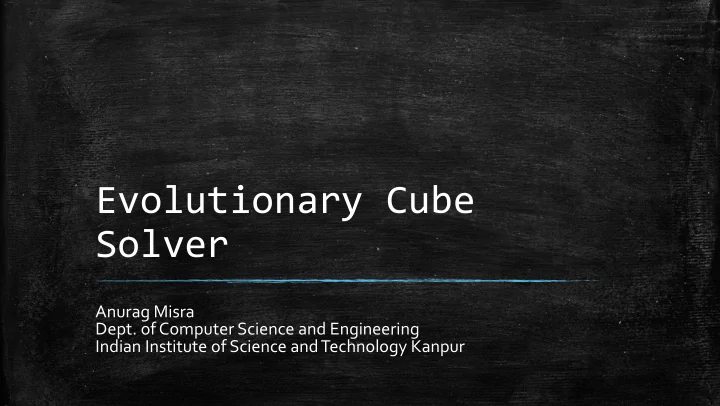

Evolutionary Cube Solver Anurag Misra Dept. of Computer Science and Engineering Indian Institute of Science and Technology Kanpur
RUBIK’S CUBE ▪ Classic 3*3*3 Rubik’s Cube invented in 1974 by Erno Rubik ▪ Highly complex puzzle ▪ 4.3 * 10^19 unique configurations ▪ Only 1 of these “solved state” ▪ Smallest number of moves to solve (“God’s Number”) yet unknown ▪ Only few exact approaches exist ▪ Most (promising) based on group theory ▪ No valid evolutionary approach incorporating group theory until now
RUBIK’S CUBE ▪ Each face is referred to by its position (relative to users viewpoint) ▪ Common notation is F, R, U, B, L, D ▪ These also stand for a 90 degree clockwise turn ▪ Correspondingly Fi, Ri, Ui, Bi, Li, Di denote counter-clockwise 90- degree turn. ▪ Moreover, F2, R2, U2, B2, L2, D2, correspond to clockwise half turns
How to go about it? ▪ Study human strategies Idea • Take human strategies and incorporate ▪ Use group theoretic them into an evolutionary approach background • Use group theoretical background to reduce complexity ▪ Evolve an algorithm Result • A more powerful evolutionary algorithm adapting human strategies and incorporating exact methods • Symbiotic Intelligence Advantage • No need of terabytes of pre-calculated lookup tables
Human strategy based genetic optimizer
Human strategy based genetic optimizer
Human strategy based genetic optimizer
EXISTING EXACT ALGORITHM: Thistlewaite Algorithm ▪ Developed by Morgan Thistlewaite in 1984 ▪ Divides the problem of solving the cube into 4-subproblems
EXISTING EXACT ALGORITHM: Thistlewaite Algorithm ▪ Transition cube from Gi Gi+1 only using moves from Gi ▪ Pre-calculated lookup-tables, solves in max. 52 moves
EXISTING EXACT ALGORITHM: Thistlewaite Algorithm ▪ Thus G(c) = <F, R, U, B, L, D> (“Cube Group”) with |G(c)| = 4.3 * 10^19
EXISTING EXACT ALGORITHM: Thistlewaite Algorithm ▪ G(0), |G(0)| = 4.3 * 10^19 * no constraint ▪ G(1), |G(1)| = 2.11 * 10^16 * orientation of edge cubies ▪ G(2), |G(2)| = 1.95 * 10^10 * orientation of corner cubies transport of edge cubies to/from middle layer ▪ G(3), |G(3)| = 6.63 * 10^5 * ……
State Complexity Reduction by Evolutionary Phase Transition
Evolution Strategy RUBIK’s cube Rubik’s cube as an individual ▪ Represented using 6 2D matrices ▪ Can be mutated only by applying move sequences ▪ Remembers all mutations undergone as a sequence list ▪ Automatically removes abundant moves after each mutation ▪ Remembers optimized sequence only
State Complexity Reduction by Evolutionary Phase Transition ▪ Scrambled cube is duplicated λ times
Evolutionary Phase Transition ▪ Each phase has it’s own fitness function, counting – Wrong oriented/positioned cubies according to group constraints – Length of the remembered sequence list ▪ Weights adjustable Example G(0) G(1): phase(o) fitness = weight.(w) + c w: = number of wrong oriented edges c: = length of the sequence list G(i) constraints satisfied if phase(i) fitness = c
State Complexity Reduction by Evolutionary Phase Transition ▪ Scrambled cube is duplicated λ times ▪ Yields first population after the phase transition ▪ Process is repeated until phase-4 is solved ▪ Selection pool generated by choosing best μ individuals from current population
References ▪ N El-Sourani, S. Hauke, M. Borschbach , “An Evolutionary Approach for Solving Rubik’s Cube Incorporating Exact Methods”, EvoApplications 2010 ▪ N El-Sourani, M. Borshbach , “Design and Comparison of two Evolutionary Approaches for Solving Rubik’s Cube” ▪ M Borshbach, C. Grelle , “Empirical Benchmarks of a Genetic Algorithm incorporating Human Strategies”, University of Applied Sciences 2010
QUESTIONS?
Recommend
More recommend